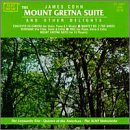| All Artists: James Cohn Title: James Cohn: Mountain Gretna Suite Members Wishing: 0 Total Copies: 0 Label: Xlnt Release Date: 3/3/1995 Genres: Special Interest, Classical Styles: Chamber Music, Forms & Genres, Concertos Number of Discs: 1 SwapaCD Credits: 1 UPC: 098941800728 |
Search - James Cohn :: James Cohn: Mountain Gretna Suite
 | James Cohn James Cohn: Mountain Gretna Suite Genres: Special Interest, Classical
|
Larger Image |
CD Details |
CD ReviewsMount Gretna Suite: a remarkable collection of works by Jame Jane Ellen | 12/06/2005 (5 out of 5 stars) "This recording features five works by American composer James Cohn: 'Concerta da Camera' (1982), 'Quintet No. 2 for Winds' (1947/1992), 'Serenade for Flute, Violin and Cello' (1990), 'Trio for Piano, Violin and Cello' (1988), and the 'Mount Gretna Suite' (1991) for chamber orchestra. As with any of Cohn's works, it is a difficult choice to make, but in the interest of space limitations this review will address three personal favourites from the album.
'Concerta da Camera' is essentially a work for violin and piano which invites a woodwind quintet along for the ride. From the very opening bars, the violin assumes emotional control of the piece with a hauntingly evocative melody. As the violin is joined by the piano, and eventually by the five winds, we are gifted with an opening movement which could literally stand by itself as a chamber work. The interplay between violin, piano, and wind section is imaginative and constantly changing in form; Cohn writes with great economy and contrasts soloists and ensemble effectively. The second movement, Andante cantabile, is more conversational in tone, heightening the tension of the piece. The final movement is a complex free fantasia on historic Dutch melodies which brings the work to a satisfying close. The 'Mount Gretna Suite' is another of Cohn's programmatic works. Although it is enhanced by paying careful attention to the liner notes, the composer has written a piece which would take the listener on a highly visual journey even if they had no knowledge of the work's origins. Interestingly, the work was commissioned for a thirteen-piece chamber orchestra, in the same combination used by Aaron Copland's masterful 'Appalachian Spring', and there are certainly similarities which can be drawn between the two pieces. However, Cohn's resulting composition is markedly different in that it attempts to convey different periods of time, using material drawn from music of the day, and also incorporating the song of the wood thrush. It is impossible to pay justice to this glorious chamber work in print, which is both majestic and light-hearted, and most definitely, American. Finally, 'Serenade for Flute, Violin and Cello' is another of Cohn's intriguing musical journeys in which he displays his fascination with different styles of music. While the first movement, 'Aubade', has a slightly French flavour, at times reminiscent of Poulenc, the second movement, 'Nocturne', is a delightful excursion into Latin American dance rhythms. 'Serenade' concludes with 'Festival', which is almost a work within itself, as driving rhythms give way to gently melodic sections before resuming the frenetic pace which brings the piece to a resounding climax." |

 Track Listings (16) - Disc #1
Track Listings (16) - Disc #1